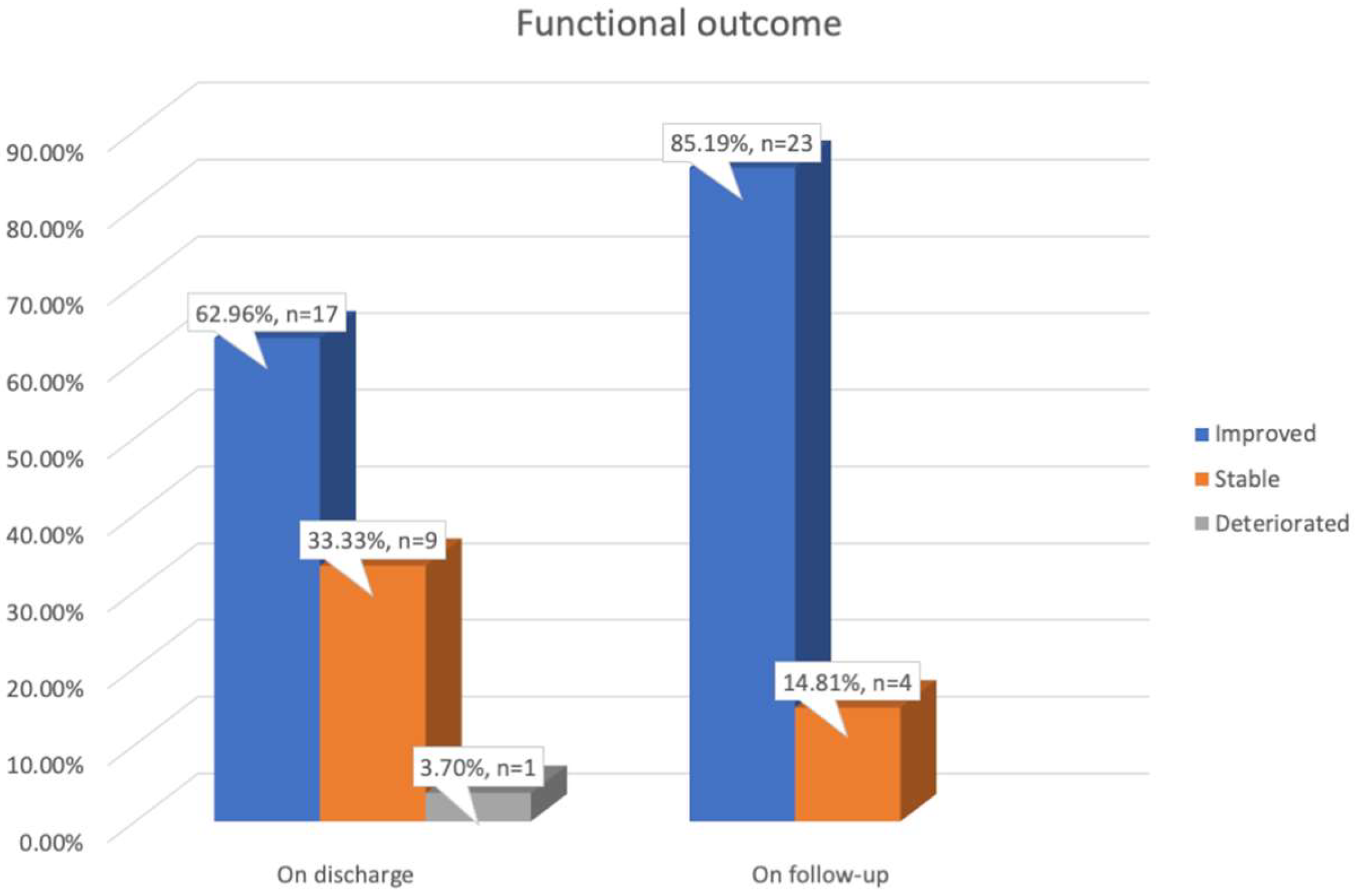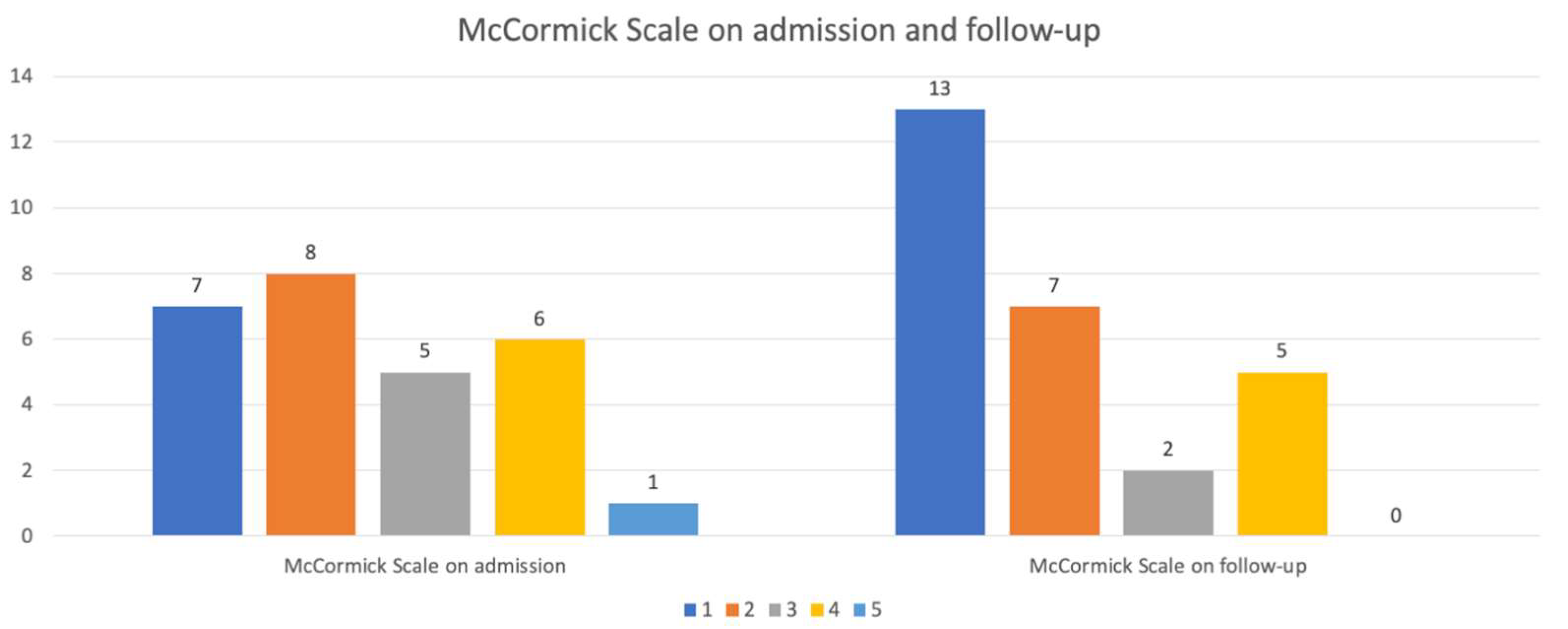Functional Outcome in Patients with Dural Arteriovenous Fistulae after Surgical Treatment
Abstract
:1. Introduction
2. Materials and Methods
2.1. Data Collection
Hospital Based Cohort Study
2.2. Statistical Analysis
2.3. Ethical Approval
3. Results
3.1. Hospital-Based Cohort Study
3.2. Treatment
3.3. Functional Outcome on Discharge and Follow-Up
4. Discussion
5. Conclusions
Author Contributions
Funding
Conflicts of Interest
Declaration
References
- Spetzler, F.R.; Detwiler, P.W.; Riina, H.A.; Porter, R.W. Modified Classification of Spinal Cord Vascular Lesions. J. Neurosurg. 2002, 96, 145–156. [Google Scholar] [CrossRef] [Green Version]
- Ropper, E.A.; Gross, B.A.; Du, R. Surgical Treatment of Type I Spinal Dural Arteriovenous Fistulas. Neurosurg. Focus 2012, 32, E3. [Google Scholar] [CrossRef]
- Jellema, K.; Tijssen, C.C.; van Gijn, J. Spinal Dural Arteriovenous Fistulas: A Congestive Myelopathy That Initially Mimics a Peripheral Nerve Disorder. Brain 2006, 129, 3150–3164. [Google Scholar] [CrossRef] [PubMed]
- Reinges, M.H.; Thron, A.; Mull, M.; Huffmann, B.C.; Gilsbach, J.M. Dural Arteriovenous Fistulae at the Foramen Magnum. J. Neurol. 2001, 248, 197–203. [Google Scholar] [CrossRef] [PubMed]
- Krings, T.; Geibprasert, S. Spinal Dural Arteriovenous Fistulas. AJNR Am. J. Neuroradiol. 2009, 30, 639–648. [Google Scholar] [CrossRef] [PubMed] [Green Version]
- Terada, T.; Higashida, R.T.; Halbach, V.V.; Dowd, C.F.; Tsuura, M.; Komai, N.; Wilson, C.B.; Hieshima, G.B. Development of Acquired Arteriovenous Fistulas in Rats Due to Venous Hypertension. J. Neurosurg. 1994, 80, 884–889. [Google Scholar] [CrossRef] [Green Version]
- Herman, J.M.; Spetzler, R.F.; Bederson, J.B.; Kurbat, J.M.; Zabramski, J.M. Genesis of a Dural Arteriovenous Malformation in a Rat Model. J. Neurosurg. 1995, 83, 539–545. [Google Scholar] [CrossRef]
- Aghakhani, N.; Parker, F.; David, P.; Lasjaunias, P.; Tadie, M. Curable Cause of Paraplegia: Spinal Dural Arteriovenous Fistulae. Stroke 2008, 39, 2756–2759. [Google Scholar] [CrossRef] [Green Version]
- Sorenson, T.; Giordan, E.; Cannizzaro, D.; Lanzino, G. Surgical Ligation of Spinal Dural Arteriovenous Fistula. Acta Neurochir. 2018, 160, 191–194. [Google Scholar] [CrossRef]
- Endo, T.; Endo, H.; Sato, K.; Matsumoto, Y.; Tominaga, T. Surgical and Endovascular Treatment for Spinal Arteriovenous Malformations. Neurol. Med. Chir. 2016, 56, 457–464. [Google Scholar] [CrossRef] [Green Version]
- Kataoka, H.; Miyamoto, S.; Nagata, I.; Ueba, T.; Hashimoto, N. Venous Congestion Is a Major Cause of Neurological Deterioration in Spinal Arteriovenous Malformations. Neurosurgery 2001, 48, 1224–1229. [Google Scholar]
- Hurst, R.W.; Kenyon, L.C.; Lavi, E.; Raps, E.C.; Marcotte, P. Spinal Dural Arteriovenous Fistula: The Pathology of Venous Hypertensive Myelopathy. Neurology 1995, 45, 1309–1313. [Google Scholar] [CrossRef] [PubMed]
- Jellema, K.; Canta, L.R.; Tijssen, C.C.; van Rooij, W.J.; Koudstaal, P.J.; van Gijn, J. Spinal Dural Arteriovenous Fistulas: Clinical Features in 80 Patients. J. Neurol. Neurosurg. Psychiatry. 2003, 74, 1438–1440. [Google Scholar] [CrossRef] [PubMed] [Green Version]
- Kai, Y.; Hamada, J.; Morioka, M.; Yano, S.; Mizuno, T.; Kuratsu, J. Arteriovenous Fistulas at the Cervicomedullary Junction Presenting with Subarachnoid Hemorrhage: Six Case Reports with Special Reference to the Angiographic Pattern of Venous Drainage. AJNR Am. J. Neuroradiol. 2005, 26, 1949–1954. [Google Scholar] [PubMed]
- Manzano, G.; Green, B.A.; Vanni, S.; Levi, A.D. Contemporary Management of Adult Intramedullary Spinal Tumors-Pathology and Neurological Outcomes Related to Surgical Resection. Spinal Cord 2008, 46, 540–546. [Google Scholar] [CrossRef]
- Benzel, E.C.; Lancon, J.; Kesterson, L.; Hadden, T. Cervical Laminectomy and Dentate Ligament Section for Cervical Spondylotic Myelopathy. J. Spinal Disord. 1991, 4, 286–295. [Google Scholar] [CrossRef]
- McCormick, P.C.; Torres, R.; Post, K.D.; Stein, B.M. Intramedullary Ependymoma of the Spinal Cord. J. Neurosurg. 1990, 72, 523–532. [Google Scholar] [CrossRef]
- Goyal, A.; Cesare, J.; Lu, V.M.; Alvi, M.A.; Kerezoudis, P.; Brinjikji, W.; Nasr, D.; Lanzino, G.; Bydon, M. Outcomes Following Surgical Versus Endovascular Treatment of Spinal Dural Arteriovenous Fistula: A Systematic Review and Meta-Analysis. J. Neurol. Neurosurg. Psychiatry. 2019, 90, 1139–1146. [Google Scholar] [CrossRef]
- Van Dijk, J.M.; TerBrugge, K.G.; Willinsky, R.A.; Farb, R.I.; Wallace, M.C. Multidisciplinary Management of Spinal Dural Arteriovenous Fistulas: Clinical Presentation and Long-Term Follow-up in 49 Patients. Stroke 2002, 33, 1578–1583. [Google Scholar] [CrossRef] [Green Version]
- Steinmetz, M.P.; Chow, M.M.; Krishnaney, A.A.; Andrews-Hinders, D.; Benzel, E.C.; Masaryk, T.J.; Mayberg, M.R.; Rasmussen, P.A. Outcome after the Treatment of Spinal Dural Arteriovenous Fistulae: A Contemporary Single-Institution Series and Meta-Analysis. Neurosurgery 2004, 55, 77–87. [Google Scholar] [CrossRef]
- Niimi, Y.; Berenstein, A.; Setton, A.; Neophytides, A. Embolization of Spinal Dural Arteriovenous Fistulae: Results and Follow-Up. Neurosurgery 1997, 40, 675–682. [Google Scholar] [CrossRef] [PubMed]
- Sherif, C.; Gruber, A.; Bavinzski, G.; Standhardt, H.; Widhalm, G.; Gibson, D.; Richling, B.; Knosp, E. Long-Term Outcome of a Multidisciplinary Concept of Spinal Dural Arteriovenous Fistulae Treatment. Neuroradiology 2008, 50, 67–74. [Google Scholar] [CrossRef] [PubMed]
- Bakker, N.A.; Uyttenboogaart, M.; Luijckx, G.J.; Eshghi, O.S.; Mazuri, A.; Metzemaekers, J.D.; Groen, R.J.; Van Dijk, J.M. Recurrence Rates after Surgical or Endovascular Treatment of Spinal Dural Arteriovenous Fistulas: A Meta-Analysis. Neurosurgery 2015, 77, 137–144. [Google Scholar] [CrossRef] [PubMed]
- Fassett, D.R.; Rammos, S.K.; Patel, P.; Parikh, H.; Couldwell, W.T. Intracranial Subarachnoid Hemorrhage Resulting from Cervical Spine Dural Arteriovenous Fistulas: Literature Review and Case Presentation. Neurosurg. Focus 2009, 26, E4. [Google Scholar] [CrossRef]
- Aviv, R.I.; Shad, A.; Tomlinson, G.; Niemann, D.; Teddy, P.J.; Molyneux, A.J.; Byrne, J.V. Cervical Dural Arteriovenous Fistulae Manifesting as Subarachnoid Hemorrhage: Report of Two Cases and Literature Review. AJNR Am. J. Neuroradiol. 2004, 25, 854–858. [Google Scholar]
- Julia Wrenczycki.14. Deutscher Wirbelsäulenkongress. Eur. Spine J. 2019, 28, 2660–2758. [Google Scholar] [CrossRef]


| Variable | Overall Cohort |
|---|---|
| Age, mean (SD) | 61.8 (8.4 SD) |
| Sex, N (%) | |
| 16 (59.3%) |
| 11 (40.7) |
| Symptoms N (%) | |
| 24 (88.9) |
| 10/25 (40) |
| 13/25 (52) |
| 9/25 (36) |
| 11/25 (44) |
| 8/25 (32) |
| 6/25 (24) |
| 2/25 (8) |
| 1/25 (4) |
| 2 (7.4) |
| Past medical history, N (%) | |
| 9 (33.3) |
| 2 (7.4) |
| 3 (11.1) |
| 1 (3.7) |
| Location, N (%) | |
| 3 (11.1) |
| 15 (55.6) |
| 8 (29.6) |
| 1 (3.7) |
| Duration of hospitalization, mean (SD) | 10.1 (6.8) |
| Functional state | |
| Cohort for spinal scores | 25/27 |
| mJOA score on admission, mean (SD) | 14 (2.9) |
| McCormick Scale on admission, N (%) | |
| 6 (24) |
| 8 (32) |
| 5 (20) |
| 6 (24) |
| mJOA score on discharge, mean (SD) | 14.2 (2.8) |
| McCormick Scale on discharge, N (%) | |
| 8 (32) |
| 5 (20) |
| 7 (28) |
| 4 (16) |
| 1 (4) |
| mJOA score on FU, mean (SD) | 15.5 (2.2) |
| McCormick Scale on FU, N (%) | |
| 12 (48) |
| 7 (28) |
| 2 (8) |
| 4 (16) |
| Univariable Analysis | |||
|---|---|---|---|
| Coefficient | 95% CI | p-Value | |
| Age, mean (SD), N(%) | −0.1 | −0.19–0.01 | 0.08 |
| Female Sex, N(%) | −0.87 | −2.73–0.99 | 0.35 |
| Worsening after surgery | 0.85 | −1.3–3 | 0.42 |
| mJOA score on admission | 0.6 | 0.4–0.81 | <0.001 |
| Univariable Analysis | |||
|---|---|---|---|
| OR | 95%CI | p-Value | |
| Age, mean (SD), N(%) | 1.11 | 0.99–1.24 | 0.06 |
| Female Sex, N(%) | 0.4 | 0.09–1.85 | 0.24 |
Publisher’s Note: MDPI stays neutral with regard to jurisdictional claims in published maps and institutional affiliations. |
© 2020 by the authors. Licensee MDPI, Basel, Switzerland. This article is an open access article distributed under the terms and conditions of the Creative Commons Attribution (CC BY) license (http://creativecommons.org/licenses/by/4.0/).
Share and Cite
Hostettler, I.C.; Butenschoen, V.M.; Meyer, B.; Wostrack, M. Functional Outcome in Patients with Dural Arteriovenous Fistulae after Surgical Treatment. Surgeries 2020, 1, 54-62. https://0-doi-org.brum.beds.ac.uk/10.3390/surgeries1020007
Hostettler IC, Butenschoen VM, Meyer B, Wostrack M. Functional Outcome in Patients with Dural Arteriovenous Fistulae after Surgical Treatment. Surgeries. 2020; 1(2):54-62. https://0-doi-org.brum.beds.ac.uk/10.3390/surgeries1020007
Chicago/Turabian StyleHostettler, Isabel C, Vicki M Butenschoen, Bernhard Meyer, and Maria Wostrack. 2020. "Functional Outcome in Patients with Dural Arteriovenous Fistulae after Surgical Treatment" Surgeries 1, no. 2: 54-62. https://0-doi-org.brum.beds.ac.uk/10.3390/surgeries1020007





